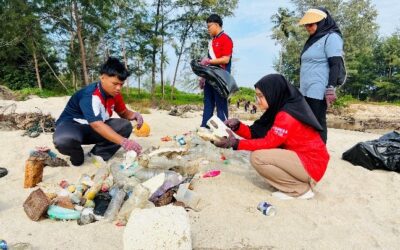Coral Resilience? Again?
You: Resilience? Again?
Me: Yep.
You: Why? Isn’t it getting boring?
You: Nope. More like frustrating.
You: Care to explain?
You: Sure.
Coral Bleaching Is Happening
Over the last couple of weeks, various sources have confirmed the emergence of the Fourth Global Bleaching Event (e.g.: ICRI). RCM has been covering this on its social media for several months; we have been tracking the NOAA satellite data on ocean temperatures and slowly watching this unfold.
It’s not like we weren’t warned. We’ve been conducting bleaching monitoring surveys around Malaysia for a few weeks now, and bleaching is emerging in some areas (though the data are still patchy).
We’ve been conducting bleaching monitoring surveys around Malaysia for a few weeks
What Is Coral Bleaching?
For those of you who haven’t already seen this, coral bleaching is what happens when corals are stressed. They expel tiny algae living inside their tissues into the surrounding water. Those algae (called zooxanthellae, or zooks for short) give the coral both its colour and most of its food. The white, calcium carbonate skeleton under the coral tissue is exposed, giving them the characteristic “bleached look”.
Coral that has been partially bleached.
And one of the main stressors is…warm water. The waters around Malaysia are usually around 28C. Currently, we are getting reports of 30-31C – too warm for corals. Hence: bleaching event.
And it’s not confined to Malaysia – it’s the whole region.
So…what can we do during coral bleaching?
To be honest? On a local level, very little.
Because we can’t control carbon dioxide (CO2) emissions at a local level – and the science suggests that CO2 emissions are leading to warming oceans – so we can’t stop ocean warming at a local level; that’s an inter-governmental thing.
That’s a global issue.
Remember – stress causes corals to expel the algae living inside them. And those algae provide the coral with a large proportion of its food, so basically, they are on a starvation diet – they become pretty weak. They can’t fight off disease as easily as they might normally, for example.
RCM monitors for coral bleaching to understand the survivability of corals after the coral bleaching event
Once a bleaching event is upon us – which is right now – about all we can do is control local threats to coral reefs, so the reefs are left as undisturbed as possible while they are in this weakened state. Unfortunately, chucking loads of ice in the water to cool it down isn’t a serious option!
Our bible on this is the Reef Manager’s Guide to Coral Bleaching which is the basis for the Bleaching Response Plan we developed after the last major bleaching event to hit Malaysia in 2010.
Will Resilience Help Coral Reefs To Survive?
Yes.
After the last major bleaching in 2010, we had to admit that taking action during a coral bleaching event is (to use an old phrase) like rearranging the deck chairs on the Titanic…makes you feel good, but ultimately, the ship is doomed to go down.
So, we looked around at what we can do to help. And resilience is the answer.
What Is Coral Resilience?
Resilience simply describes a characteristic of ecosystems (and people and societies) that reflects their ability to withstand or bounce back after a major external threat/event.
Take the COVID pandemic – the healthiest economies – the most resilient ones – were the first to bounce back once the pandemic ended.
So, while, at a local level, there’s not much we can do about CO2 levels in the atmosphere, we can identify the major threats facing reefs locally, and do something to manage them so that reefs are as healthy as possible to withstand and recover from future bleaching events.
The Key Coral Resilience Factors
The key resilience factors that we need to protect are:
-
Water quality: we need to reduce pollution from sewage, land clearing, etc
-
Physical impacts: which on our islands is mainly tourism. We need to manage tourism better – less tourists perhaps? Better management of activities such as diving and snorkelling so people aren’t using anchors or standing on corals…
-
Herbivores: that’s “grass-eating fish” to you and I…certain fish (like parrot fish) graze on algae that grow on dead coral; taking out the herbivores means algae grows unchecked, smothering the surface of the reef, and preventing corals from re-growing. We have to stop fishing on the reefs.
There are still locals resorting to unsustainable fishing practices such as fishbombing.
It’s not rocket science.
Taking these few simple measures would help to build the resilience of the reefs, enhancing their chances of surviving a bleaching event.
What Do We Need To Do Now To Build Resilience?
Somehow, we don’t seem to be able to get it together to actually do much about resilience. And with the onset of this latest global bleaching event, I’m not sure that reefs are that much more resilient than they were back in 2010.
This is important because if reefs start to die off, we lose an important habitat for fisheries. Reefs are said to provide a home for 25% of all marine life.
Simply put (and it’s not the first time I’ve said this): no reefs, no fish. Not to mention all the tourist jobs they support.
But responsibility for managing these various issues is spread between a variety of institutions at the state and federal levels, and we haven’t found a way to get them working together.
That’s the frustration! It’s no one’s fault, really; it’s a feature of Malaysia’s system of government. Silo thinking, perhaps?
Our Role In Building Coral Resilience
We can all play a role in helping to resolve this:
-
Managing water quality? Speak to the local government and housing people; involve state governments.
-
Physical impacts? Speak to MOTAC about limiting tourist numbers; encourage local operators to adopt reef-friendly practices.
-
Herbivores? Educate coastal communities about how important they are in the ecosystem.
We need to limit tourist numbers and encourage local operators to adopt reef-friendly practices
It’s going to take a collective effort. Time to end silo thinking!
We are open to suggestions and collaborations to address the challenges raised above. We can’t overestimate the urgency of making progress to address local threats to coral reefs – well-known, with simple, mainly low-cost solutions – so we can build resilience.
Bleaching is happening now; it will happen again. Write your representative; or feel free to contact us at hello@reefcheck.org.my if you have any ideas or suggestions.
______________________________________________________________________________________
If you’d like to support us, you can follow our social media pages for any updates on our work and volunteering opportunities, or donate towards our cause.








